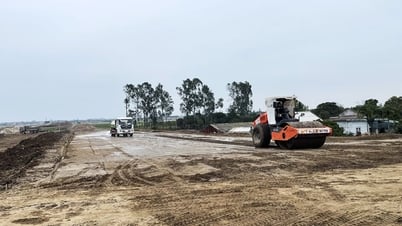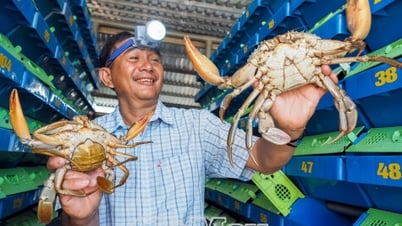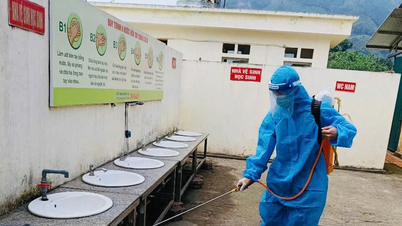In late June, farmers in localities in the province gathered equipment to prepare the land, take care of seedlings, and mobilized human resources to go to the fields to sow and plant winter-spring rice to ensure the crop schedule.
This year's crop, the whole province strives to sow and plant more than 23,890 hectares of rice; complete sowing and planting before July 15. The structure of early-season rice accounts for 5-10%, mid-season rice accounts for 90-95% of the cultivated area; high-quality rice accounts for over 70% of the area. To ensure the plan on area, crop calendar, and variety structure, before entering the production season, the agricultural sector and localities have proactively directed and urged farmers to gather land preparation equipment as soon as they harvest spring rice, proceed with soil preparation, sow seedlings; provide technical guidance, support seeds, materials, and fertilizers for farmers to sow and plant winter-season rice, and actively prepare plans to prevent and combat flooding.

In late June, together with farmers in other localities in the province, farmers in Kim Dong district are urgently going to the fields to sow the winter-spring rice crop. Ms. Nguyen Thi Phuong, a farmer in Song Mai commune, said: Entering the winter-spring crop production, the cooperative has proactively prepared the land and provided rice seeds for farmers to sow rice seedlings to ensure the season. On hot days, households proactively sow rice in the early morning, late afternoon and at night to limit the impact of the weather on the growth of rice plants after sowing. In the past few days, it has been raining heavily, so we have focused on preventing flooding in the seedling area and the direct-sown rice area.
To ensure the structure of varieties and crops, before harvesting spring rice, localities in Kim Dong district require tractor owners to focus on repairing, upgrading, and replacing old and damaged tillage equipment; buy new tillage machines with larger capacity, tilling the soil thoroughly and smoothly according to the motto "harvesting to where, tilling the soil immediately"; prioritize large-capacity tractors tilling low-lying fields, fields with "lost" fields, good stubble, etc. Therefore, the situation of rice harvesting before moving on to tilling the soil has been overcome, and the tractor owners have forced down prices, slowing down the tillage progress. In addition, officials of the district's Department of Agriculture and Rural Development actively recommend that farmers use some biological products or lime powder to fertilize the soil to promote rapid decomposition of stubble, limit root suffocation, physiological yellowing of leaves, and limit the spread of pests and diseases to the crop. With synchronous implementation measures, by June 27, farmers in the district had completed the first land preparation and were focusing on speeding up the second land preparation. At the same time, more than 125 hectares of rice seedlings were sown and 30 hectares were planted. The entire district strives to complete the winter-spring rice planting plan by July 15.
By June 27, Phu Cu district farmers had planted 310 hectares of winter-spring rice. Before that, the district had completed plowing and stubble removal and the second tillage of over 50% of the area. This year's winter-spring crop, the entire district plans to plant 3,216 hectares, of which high-quality rice accounts for 70% of the area, including: Hung Yen fragrant sticky rice, various types of sticky rice, Dai Thom 8, Tien Hai 1, Huong Binh... The area of high-yield rice accounts for 30% of the area. The structure is 10-15% of the early-season tea area and 85-90% of the mid-season tea area. Winter-spring crop production often encounters flooding and this is also the time of year with heavy rainfall, so the district directs agricultural service cooperatives to proactively contact agricultural seed suppliers and spring rice seed production cooperatives to purchase rice seeds from the provincial budget, and instructs localities to plan areas and sow reserve rice seedlings. In addition, the district instructs localities to prepare reserve rice based on the area plan and characteristics of each variety and each locality, ensuring the quantity of seeds according to the province's plan. At this time, the district strengthens recommendations for farmers to plant rice seedlings at the right age, ensuring the number of tillers and density according to the intensive farming process of each variety. Expand the area of direct sowing at the foot of highlands and highlands with proactive watering to reduce costs and labor, reduce labor pressure at the beginning of the season...
By June 27, farmers in the province had completed the first land preparation for more than 22,400 hectares, the second land preparation for nearly 12,600 hectares, sown rice seedlings for more than 1,700 hectares, and planted nearly 2,600 hectares of rice. To ensure the plan on area and time for winter-spring rice planting, localities in the coming days need to mobilize maximum means to prepare the land quickly, flexibly transfer land preparation machines to suit each field. Use biological products, antagonistic fungi, lime powder... to sprinkle stubble to quickly decompose, ensure soil quality for planting, limit pests and diseases from spring to summer; prepare the soil thoroughly, apply enough fertilizer before planting. Speed up the sowing progress according to the directed crop schedule. Protect and care for the sown rice seedlings to ensure good, healthy seedlings, free of pests and diseases, and not affected by rain or waterlogging before planting. Sow when the seedlings are old enough to be planted, mobilize maximum human resources and means to sow quickly and focus on ensuring that sowing is completed before July 15; recommend that farmers sow when the weather is cool (afternoon, early morning) to help the rice recover quickly, sow from bottom to top (low-lying fields, low-lying areas are planted first, high-lying areas, proactively sow water first) so that the rice can grow and develop early, avoiding being affected by heavy rain causing local flooding. Maximize the area of machine-planted rice, reduce the area of directly sown rice to limit risks caused by weather.
Dao Ban
Source: https://baohungyen.vn/xuong-dong-gioo-cay-lua-mua-3173427.html





![[Photo] Prime Minister Pham Minh Chinh and Prime Minister of the Kingdom of Thailand Paetongtarn Shinawatra attend the Vietnam-Thailand Business Forum 2025](https://vphoto.vietnam.vn/thumb/1200x675/vietnam/resource/IMAGE/2025/5/16/1cdfce54d25c48a68ae6fb9204f2171a)


























![[Photo] President Luong Cuong receives Prime Minister of the Kingdom of Thailand Paetongtarn Shinawatra](https://vphoto.vietnam.vn/thumb/1200x675/vietnam/resource/IMAGE/2025/5/16/52c73b27198a4e12bd6a903d1c218846)
































































Comment (0)